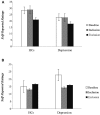Dull to Social Acceptance Rather than Sensitivity to Social Ostracism in Interpersonal Interaction for Depression: Behavioral and Electrophysiological Evidence from Cyberball Tasks
- PMID: 28408877
- PMCID: PMC5374192
- DOI: 10.3389/fnhum.2017.00162
Dull to Social Acceptance Rather than Sensitivity to Social Ostracism in Interpersonal Interaction for Depression: Behavioral and Electrophysiological Evidence from Cyberball Tasks
Abstract
Objectives: Impairments in interpersonal relationships in depression present as irritability, pessimism, and withdrawal, and play an important role in the onset and maintenance of the disorder. However, we know little about the neurological causes of this impaired interpersonal function. This study used the event-related brain potential (ERP) version of the Cyberball paradigm to investigate the emotions and neural activities in depressive patients during social inclusion and exclusion simultaneously to explore neuropsychological mechanisms. Methods: Electrophysiological data were recorded when 27 depressed patients and 23 healthy controls (HCs) performed a virtual ball tossing game (Cyberball) during which the participants believed they were playing with two other co-players over the internet. The Cyberball paradigm included two other conditions; inclusion during which participants received the ball with the same probability as the other players to experience a feeling of acceptance, and exclusion during which the participants experienced a feeling of ostracism when the other two players threw the ball with each other. The Positive and Negative Affect Schedule (PANAS) was used as a baseline and after each block during the Cyberball to assess positive and negative effects. In addition, a brief Need-Threat Scale (NTS) was used to assess the fulfillment of basic needs of subjects after each block and 10 min after ostracism. Moreover, the relationship between the ERP data of depression and clinical symptoms was analyzed. Results: Exclusion compared to inclusion Cyberball caused a decrease in positive affect and an increase in negative affect. The group differences were only found in the positive affect. Moreover, patients reported a lower level of basic needs than did HCs after social inclusion, but a similar level of basic needs after social exclusion. At the electrophysiological level, patients showed decreased P3 amplitudes compared to HCs in social inclusion, and P3 amplitudes were borderline negatively correlated with their scores of anhedonia symptoms. Limitations: A limitation of our study was that the subjects' criteria were different. Conclusions: The behavioral and electrophysiological results indicated that the interpersonal problems in depressive patients were mainly due to deficits in processing the pleasurable social stimuli rather than aversive social cues.
Keywords: cyberball; depression; event-related potential (ERP); social exclusion; social inclusion.
Figures





References
-
- Brislin R. W. (1970). Back-translation for cross-cultural research. J. Cross Cult. Psychol. 1, 185–216. 10.1177/135910457000100301 - DOI
-
- Bruijniks S. J. E., Bosmans J., Peeters F. P. M. L., Hollon S. D., van Oppen P., van den Boogaard M., et al. . (2015). Frequency and change mechanisms of psychotherapy among depressed patients: study protocol for a multicenter randomized trial comparing twice-weekly versus once-weekly sessions of CBT and IPT. BMC Psychiatry 15:137. 10.1186/s12888-015-0532-8 - DOI - PMC - PubMed
LinkOut - more resources
Full Text Sources
Other Literature Sources

